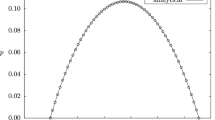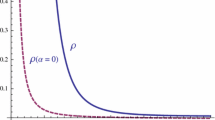Abstract
We determine the complete solution of the Einstein field equations for the case of a spherically symmetric distribution of gaseous matter, characterized by a polytropic equation of state. We show that the field equations automatically generate two sharp boundaries for the gas, an inner one and an outer one, given by radial positions \(r_{1}\) and \(r_{2}\), and thus define a shell of gaseous matter outside of which the energy density is exactly zero. Hence this shell is surrounded by an outer vacuum region, and surrounds an inner vacuum region. Therefore, the solution is given in three regions, one being the well-known analytical Schwarzschild exterior solution in the outer vacuum region, one being determined analytically in the inner vacuum region, and one being determined partially analytically and partially numerically, within the matter region, between the two boundary values \(r_{1}\) and \(r_{2}\) of the Schwarzschild radial coordinate r. This solution is therefore somewhat similar to the one previously found for a spherically symmetric shell of liquid fluid, and is in fact exactly the same in the cases of the inner and outer vacuum regions. The main difference is that here the boundary values \(r_{1}\) and \(r_{2}\) are not chosen arbitrarily, but are instead determined by the dynamics of the system. As was shown in the case of the liquid shell, also in this solution there is a singularity at the origin, that just as in that case does not correspond to an infinite concentration of matter, but in fact to zero matter energy density at the center. Also as in the case of the liquid shell, the spacetime within the spherical cavity is not flat, so that there is a non-trivial gravitational field there, in contrast with Newtonian gravitation. This inner gravitational field has the effect of repelling matter and energy away from the origin, thus avoiding a concentration of matter at that point.








Similar content being viewed by others
Data Availability
Data sharing not applicable to this article as no datasets were generated or analyzed during the current study.
References
deLyra, J.L., Orselli, R.D.A., and Carneiro, C.E.I.: Exact solution of the einstein field equations for a spherical shell of fluid matter, 2021 arXiv:2101.02012, https://doi.org/10.5281/zenodo.5087611.
Tooper, R.F.: General relativistic polytropic fluid spheres. Astrophys. J. 140, 434–459 (1964)
Ni, J.: Solutions without a maximum mass limit of the general relativistic field equations for neutron stars. Sci. China 54(7), 1304–1308 (2011)
Neslušan, L.: The Ni’s solution for neutron star and outward oriented gravitational attraction in its interior. J. Modern Phys. 6, 2164–2183 (2015)
Neslušan, L.: The second rise of general relativity in astrophysics. Modern Phys. Lett. A 34, 1950244-1–1950244-24 (2019)
Dirac, P.A.M.: General Theory of Relativity. Wiley, Hoboken (1975). (ISBN 0-471-21575-9)
Wald, R.: General Relativity. University of Chicago Press, Chicago (2010)
Jebsen, J.T.: Über die allgemeinen kugelsymmetrischen lösungen der einsteinschen gravitationsgleichungen im vakuum (on the general spherically symmetric solutions of einstein’s gravitational equations in vacuo). Arkiv för Matematik, Astronomi och Fysik 15, 1–9 (1921)
Birkhoff, G.D.: Relativity and Modern Physics. Harvard University Press: Cambridge, p. 23008297. Massachusetts, LCCN (1923)
Landau, L.D., Lifshitz, E.M.: The Classical Theory of Fields, 4th edn. Butterworth-Heinemann, New York (1980)
Weinberg, S.: Gravitation and Cosmology. Wiley, New York (1972)
Misner, C.W., Thorne, K.S., Wheeler, J.A.: Gravitation. W.H. Freeman and Co., San Francisco (1973)
Acknowledgements
The authors would like to thank Mr. Rodrigo de A. Orselli for all his help during the work that eventually led to this paper, as well as for his reading of the manuscript and helpful criticism regarding this work.
Author information
Authors and Affiliations
Corresponding author
Ethics declarations
Conflict of interest
The authors hereby certify that there are no actual or potential conflicts of interest of any of the authors in relation to this article.
Additional information
Publisher's Note
Springer Nature remains neutral with regard to jurisdictional claims in published maps and institutional affiliations.
Rights and permissions
Springer Nature or its licensor (e.g. a society or other partner) holds exclusive rights to this article under a publishing agreement with the author(s) or other rightsholder(s); author self-archiving of the accepted manuscript version of this article is solely governed by the terms of such publishing agreement and applicable law.
About this article
Cite this article
L. deLyra, J., Carneiro, C.E.I. Complete solution of the Einstein field equations for a spherical distribution of polytropic matter. Gen Relativ Gravit 55, 67 (2023). https://doi.org/10.1007/s10714-023-03115-6
Received:
Accepted:
Published:
DOI: https://doi.org/10.1007/s10714-023-03115-6




